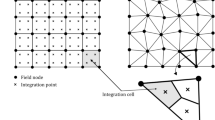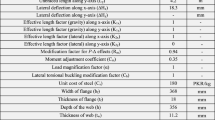Abstract
This work improves our previous stress-constrained topology optimization method (Fan et al., in Struct Multidisc Optim 59:647–658, 2019) and provides an application of the improved method to a typical aircraft engine bracket design problem. The original method was built upon the bi-directional evolutionary structural optimization (BESO) method with an extension to account for stress constraints. In this work, we first improve the method by means of a more efficient and versatile self-adaptive scheme for the determination of the Lagrange multiplier. The improved method is then applied for the design of a typical aircraft engine bracket considering multiple practical load conditions. The resulting bracket topology from stress-constrained design is further smoothed and detailed using basic CAD (Computer-Aided Design) primitives. Numerical results show that the reconstructed bracket design evidently outperforms than the original bracket design in terms of weight, stiffness, and strength.

















Similar content being viewed by others
References
Bendsøe MP, Kikuchi N (1988) Generating optimal topologies in structural design using a homogenization method. Comput Methods Appl Mech Eng 71:197–224
Bruggi M (2008) On an alternative approach to stress constraints relaxation in topology optimization. Struct Multidisc Optim 36:125–141
Cai S, Zhang W, Zhu J, Gao T (2014) Stress constrained shape and topology optimization with fixed mesh: a B-spline finite cell method combined with level set function. Comput Methods Appl Mech Eng 278:361–387
Chen A, Cai K, Zhao ZL, et al (2020) Controlling the maximum first principal stress in topology optimization. Struct Multidisc Optim
Deaton JD, Grandhi RV (2014) A survey of structural and multidisciplinary continuum topology optimization: post 2000. Struct Multidisc Optim 49:1–38
Duysinx P, Sigmund O (1998) New developments in handling stress constraints in optimal material distribution. 7th AIAA/USAF/NASA/ISSMO Symp Multidiscip Anal Optim 1501–1509.
Fan Z, Xia L, Lai W et al (2019) Evolutionary topology optimization of continuum structures with stress constraints. Struct Multidisc Optim 59:647–658
Guo X, Cheng GD (1997) S-relaxed approach in structural topology optimization. Struct Optim 258–266
Guo X, Zhang WS, Wang MY, Wei P (2011) Stress-related topology optimization via level set approach. Comput Methods Appl Mech Eng 200:3439–3452
Huang X, Xie YM (2007) Convergent and mesh-independent solutions for bi-directional evolutionary structural optimization method.Finite Elem Anal Des 43:1039–1049
Kirsch U (1990) On singular topologies in optimum structural design. Struct Optim 2:133–142
Le C, Norato J, Bruns T et al (2010) Stress-based topology optimization for continua. Struct Multidisc Optim 41:605–620
Liu B, Guo D, Jiang C et al (2019) Stress optimization of smooth continuum structures based on the distortion strain energy density. Comput Methods Appl Mech Eng 343:276–296
Nabaki K, Shen J, Huang X (2019) stress minimization of structures based on bidirectional evolutionary procedure. J Struct. Eng 145(2):04018256.1-04018256.14
Nabaki K, Shen J, Huang X (2019) Evolutionary topology optimization of continuum structures considering fatigue failure. Mater Design 166:107586.1-107586.13
Picelli R, Townsend S, Brampton C et al (2018a) Stress-based shape and topology optimization with the level set method. Comput Methods Appl Mech Eng 329:1–23
Picelli R, Townsend S, Kim HA (2018b) Stress and strain control via level set topology optimization. Struct Multidisc Optim 58:2037–2051
Rozvany GIN, Sobieszczanski-Sobieski J (1992) New optimality criteria methods: Forcing uniqueness of the adjoint strains by corner-rounding at constraint intersections. Struct Optim 4:244–246
Senhora FV, Giraldo-Londoño O, Menezes IFM, Paulino GH (2020) Topology optimization with local stress constraints: a stress aggregation-free approach. Struct Multidisc Optim 62:1639–1668
Song Y, Ma Q, He Y et al (2020) Stress-based shape and topology optimization with cellular level set in B-splines. Struct Multidisc Optim 62:2391–2407
Xia L, Xia Q, Huang X, Xie YM (2018a) Bi-directional evolutionary structural optimization on advanced structures and materials: a comprehensive review. Arch Comput Methods Eng 25:437–478
Xia L, Zhang L, Xia Q, Shi T (2018b) Stress-based topology optimization using bi-directional evolutionary structural optimization method. Comput Methods Appl Mech Eng 333:356–370
Xia Q, Shi T, Liu S, Wang MY (2012) A level set solution to the stress-based structural shape and topology optimization. Comput Struct 90–91:55–64
Xu B, Han Y, Zhao L (2020a) Bi-directional evolutionary stress-based topology optimization of material nonlinear structures
Xu B, Han Y, Zhao L (2020b) Bi-directional evolutionary topology optimization of geometrically nonlinear continuum structures with stress constraints. Appl Math Model 80:771–791
Yang RJ, Chen CJ (1996) Stress-based topology optimization. Struct Optim 12:98–105
Zhang W, Jiang S, Liu C et al (2020) Stress-related topology optimization of shell structures using IGA/TSA-based Moving Morphable Void (MMV) approach. Comput Methods Appl Mech Eng 366:113036
Zhang W, Li D, Zhou J et al (2018) A Moving Morphable Void (MMV)-based explicit approach for topology optimization considering stress constraints. Comput Methods Appl Mech Eng 334:381–413
Zhou M, Sigmund O (2017) On fully stressed design and p-norm measures in structural optimization. Struct Multidisc Optim 56:731–736
Zhu JH, Zhang WH, Xia L (2016) Topology optimization in aircraft and aerospace structures design. Arch Comput Methods Eng 23:595–622
Funding
This work is supported by National Key R&D Project (2020YFB1709401), National Natural Science Foundation of China (11972166), Natural Science Foundation for Distinguished Young Scholars of Hubei province of China (2020CFA080), Fundamental Research Funds for the Central Universities (2019kfyXKJC044), Aeronautics Power Foundation (6141B090564), and Natural Science Foundation of Shaanxi Province of China (2021JM-043).
Author information
Authors and Affiliations
Corresponding author
Ethics declarations
Conflict of interest
The authors declare that they have no conflict of interest.
Replication of results
All necessary details have been included and the 2D benchmark results can be replicated accordingly by extending our previously released BESO code (Xia et al. 2018a). The CAD and FEA models of the newly design bracket (Figs. 14 and 15) are available as supplementary material.
Additional information
Responsible Editor: Gengdong Cheng
Publisher's Note
Springer Nature remains neutral with regard to jurisdictional claims in published maps and institutional affiliations.
Supplementary Information
Below is the link to the electronic supplementary material.
Appendices
Appendix 1: Sensitivity analysis
By the BESO method, sensitivities are evaluated only for solid elements while are set directly to zero for void elements. The derivative of the modified design objective \({f}_{2}\) w.r.t. \({x}_{i}\) equals
in which the first term can be easily derived as
and \({\mathbf{k}}_{i}^{\left(0\right)}\) is the stiffness matrix of the i-th element with solid material.
According to the definition in (5), the second term in (A1) is derived as
Recalling the definition of von Mises stress,
with \({\varvec{\sigma}}\) the stress in the Voigt notation and \(\mathbf{V}\) the stress coefficient matrix, the derivative of j-th element von Mises stress w.r.t. the stress vector equals
and by the chain rule, the derivative of \({\sigma }_{vm,j}\) w.r.t. \({x}_{i}\) equals
It is defined and assumed in (1) that \({\mathbf{D}}_{0}\) and \({\mathbf{B}}_{i}\) are independent with the associated design variable and thus (A6) can be further written as
where \({\mathbf{L}}_{j}\)is the gathering matrix (\({\mathbf{u}}_{j}={\mathbf{L}}_{j}\mathbf{U}\)). As the external force is assumed to be independent with topology change, (A7) can thus be further written as
using the differential property of
Substituting (A8) into (A3) yields
and with the adjoint solution of following
(A10) can be simplified to
where \({\mathbf{\varphi }}_{i}\)is the vector of the adjoint nodal values of the i-th element (\({\mathbf{\varphi }}_{j}={\mathbf{L}}_{j}{\varvec{\Phi}}\)).
Finally, substituting (A2) and (A12) into (A1), the sensitivity of the modified objective function w.r.t. \({x}_{i}\) euqals
Appendix 2: BESO variables update scheme
Starting from full solid material design, the allowed material usage at the current design iteration is determined as
in which the evolutionary ratio \({c}_{\rm {er}}\) determines the material removal rate, the superscript \(l\) denotes the design iteration.
Sensitivity numbers denoting the relative ranking of elemental contribution of the design objective are used to guide material removal and addition. When uniform meshes are used, the sensitivity number for is defined using the sensitivity computed from (A13)
where \({x}_{i}\) serves as an indicator to simply ensure that sensitivity numbers are evaluated only for solid elements \(({x}_{i}=1)\), while are enforced to zero for void elements \(({x}_{i}=0)\). In view of the highly nonlinear stress behavior, both sensitivity numbers and topology design variables are filtered to stabilize the optimization procedure. To maintain the material recovery mechanism, sensitivity filter radius is set \({r}_{\rm {sen}}=2{h}_{e}\) with \({h}_{e}\) the typical element length. The filtered sensitivity numbers are stabilized with their historical information to improve the convergence.
All elements are sorted into a vector according to their sensitivity number values. Then, the update of the topology design variables is realized by means of a threshold parameters \({\alpha }_{\rm {th}}\)
The present scheme indicates that solid elements are removed when their sensitivity numbers are less than \({\alpha}_{\rm {del}}^{\rm {th}}\) and void elements are recovered when their sensitivity numbers are greater than \({\alpha }_{\rm {add}}^{\rm {th}}\). The parameters \({\alpha }_{\rm {del}}^{\rm {th}}\) and \({\alpha }_{\rm {add}}^{\rm {th}}\) are obtained from the following iterative algorithm:
-
1.
Let \({\alpha }_{\rm {del}}^{\rm {th}}={\alpha }_{\rm {add}}^{\rm {th}}={\alpha }_{\rm {th}}\), where the value of \({\alpha }_{\rm {th}}\) is determined iteratively such that the current allowed material volume is met.
-
2.
Compute the admission ratio \({c}_{\rm {ar}}\) as the volume of recovered elements divided by the total volume. If \({c}_{\rm {ar}}\le {c}_{\rm {ar}}^{\rm {max}}\), the maximum admission ratio, skip the next steps; otherwise, \({\alpha }_{\rm {del}}^{\rm {th}}\) and \({\alpha }_{\rm {add}}^{\rm {th}}\) are re-determined in the next steps.
-
3.
Determine \({\alpha }_{\rm {add}}^{\rm {th}}\) iteratively from the sensitivity numbers of void elements until the maximum admission ratio is met, i.e., \({c}_{\rm {ar}}\approx {c}_{\rm {ar}}^{\rm {max}}\).
-
4.
Determine \({\alpha }_{\rm {del}}^{\rm {th}}\) iteratively from the sensitivity numbers of the solid elements until the current allowed material volume is met.
Finally, the obtained binary topology variables are filtered with a radius \({r}_{\rm{den}}\) to ensure the convergence and mesh independency of the design. The resulting intermediate densities are then converted into the discrete design through a post-processing procedure according to a determined density threshold satisfying the current material volume usage constraint.
Rights and permissions
About this article
Cite this article
Wu, Y., Qiu, W., Xia, L. et al. Design of an aircraft engine bracket using stress-constrained bi-directional evolutionary structural optimization method. Struct Multidisc Optim 64, 4147–4159 (2021). https://doi.org/10.1007/s00158-021-03040-9
Received:
Revised:
Accepted:
Published:
Issue Date:
DOI: https://doi.org/10.1007/s00158-021-03040-9




